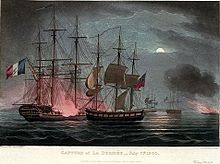| Raid on Dunkirk | |||||||
|---|---|---|---|---|---|---|---|
| Part of the naval operations during the War of the Second Coalition | |||||||
 Capture of La Desirée, Thomas Whitcombe | |||||||
| |||||||
| Belligerents | |||||||
|
|
| ||||||
| Commanders and leaders | |||||||
|
|
| ||||||
| Strength | |||||||
|
2 frigates 1 sloop 4 fireships | 4 frigates | ||||||
| Casualties and losses | |||||||
|
18 killed and wounded 4 fireships destroyed |
100 killed and wounded 1 frigate captured | ||||||
The Raid on Dunkirk of 7 July 1800 was an attack by a British Royal Navy force on the well-defended French anchorage of Dunkirk in the English Channel during the French Revolutionary Wars. French naval forces had been blockaded in their harbours during the conflict, and often the only method of attacking them was through fireships or "cutting-out" expeditions, in which boats would carry boarding parties into the harbour at night, seize ships at anchor and bring them out. The attack on Dunkirk was a combination of both of these types of operation, aimed at a powerful French frigate squadron at anchor in Dunkirk harbour. The assault made use of a variety of experimental weaponry, some of which was tested in combat for the first time with mixed success.
Although assault by the heavily armed sloop HMS Dart proved successful, the fireships achieved little and various other British craft involved in the operation had little effect on the eventual outcome. The French response was disorganised and ineffectual, losing one frigate captured. Three others were almost destroyed, only escaping by cutting their anchor cables and fleeing into the coastal shoals where they ran aground. Although all three frigates were refloated and returned to service, the operation had cost the French heavy casualties. The British force suffered minimal losses, although the exact totals are uncertain. Many of the British officers involved were highly praised and rewarded with promotions and prize money.